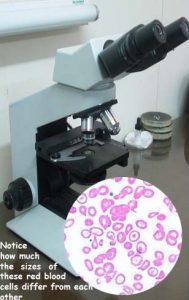Ron Hines DVM PhD
Anisocytosis
Your veterinarians will occasionally see a note or check-off from the clinical chemist who reviewed your dog or cat’s blood film slides stating that “anisocytosis was noticed”. What this means is that he/she observed under a microscope that your pet’s red blood cells were not all the same size. When red blood cells vary in their size, it is usually a sign of anemia.
As an anemic pet’s body hurries to produce and release missing red blood cells from its bone marrow, some are released too soon or defective.
Other signs that might occur when this problem present are red blood cells in circulation that vary in shape (poikilocytosis), RBCs that are round rather than disc shaped (spherocytes) or that vary in color (polychromasia), contain RNA remnants within them (=reticulocytes) or round inclusions (Heinz bodies).
Problems That Can Cause Anisocytosis In Your Dog Or Cat’s Red Blood Cells:
Although any of the many causes of anemia can cause anisocytosis in your pet, cases that are not easily explained are often due to autoimmune anemias. Cancers of the bone marrow (similar to multiple myeloma), feline leukemia in cats, onion or garlic poisoning and certain medications can also cause anisocytosis.
Complementary tests:
PCV, Hemoglobin level, if they are low then all the many causes of anemia need to be explored. WBC count, reticulocyte count, Coombs test, ANA test, thrombocyte count, leukocyte count, bilirubin, prothrombin time or APTT, B12 and folic acid level
DxMe
You are on the Vetspace animal health website
Visiting the products that you see displayed on this website help pay the cost of keeping these articles on the Internet.
